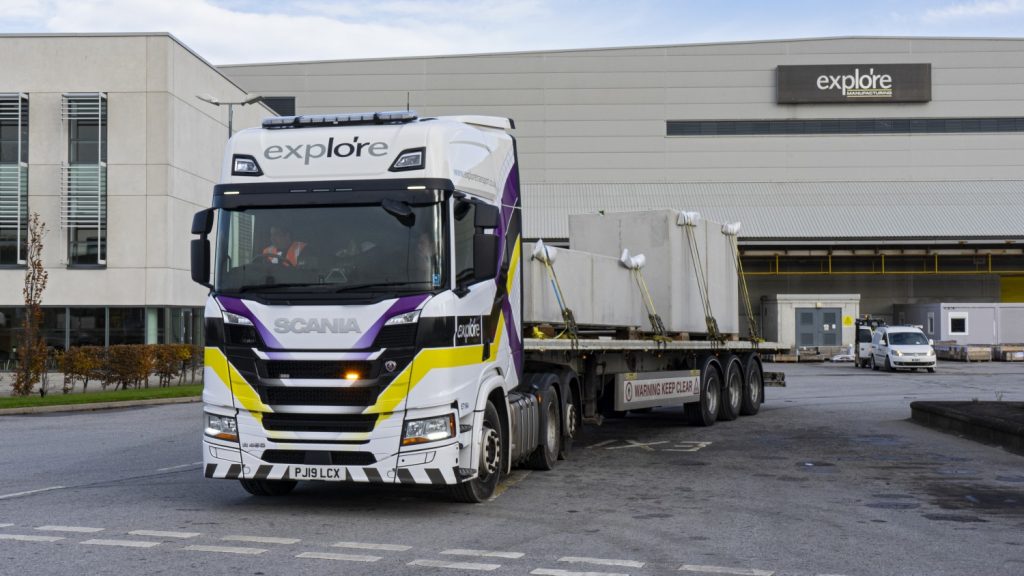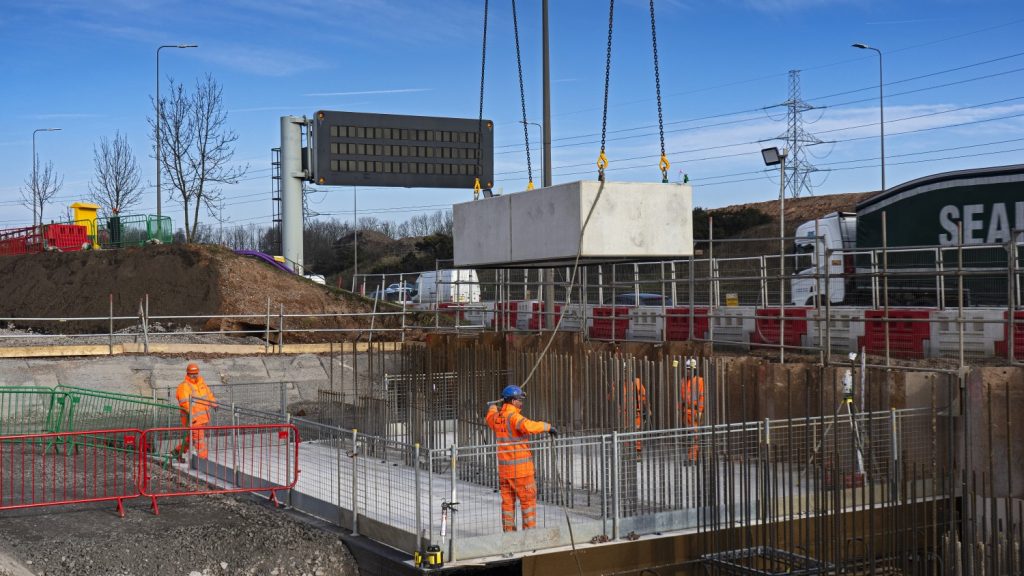Build, build, build! – heartening words for construction. Better, greener, faster – the imperatives for the industry. But what remains unspoken is the poor past-performance of the sector. Since the mid-1990s, the productivity of manufacturing has improved by 50 per cent. In the same period, construction productivity has remained unchanged.
The uptake of manufacturing-style techniques, so-called ‘modern methods of construction’, is being promoted as a means of closing the productivity gap. These methods include off-site manufacture.
The use of transporters to ‘drive in’ prefabricated bridge decks is widespread in the rail industry, to permit construction within short possession constraints. But can similar techniques be adopted for the substructures?

In a 12-month, £1 million development project, Laing O’Rourke, supported by WSP and Ramboll, created a set of pre-approved modular bridge products to enable more off-site manufactured components to be used in the delivery of bridges. The project is a result of the competition that Highways England launched in February 2019, alongside Innovate UK, to encourage new ideas aimed at revolutionising roads and driving. HS2 enabling works contractor LMJV (Laing O’Rourke and J Murphy & Sons Joint Venture) used these products in the construction of the M42 bridge installed over the weekend of 8-9 August 2020.
Off-site advantage
Phil Robinson, civil engineering leader at Laing O’Rourke’s Dartford headquarters, commented: “Off-site manufacturing is at the heart of Laing O’Rourke’s business. Over a decade ago, we invested in a state-of-the-art precast factory in Nottinghamshire, and it remains the most automated concrete production facility in Europe. We have a target of 70 per cent of the construction being conducted off-site, leading to a 60 per cent improvement in productivity, and a 30 per cent improvement in delivery schedule.
“We have been recognised for many years for our modular products in the buildings sector,” Phil continued. “The Highways England funding offered a perfect opportunity for us to accelerate our efforts to grow our product range and achieve a step-change in the delivery of bridges.”
An obvious key benefit of using off-site products is faster construction, saving indirect costs and reducing disruption to the transport network. But there are other inherent benefits to using off-site modular products.
The repetition of assembling standard units, with site teams familiar with working with the components, reduces construction risk compared to one-off solutions. The transfer of labour hours from site into the controlled conditions of the factory improves well-being, with better environmental and ergonomic working arrangements. Also, safety is designed into the system, with reduced work at height.

Modular abutments
Recognising that standardised precast deck beams have been used for decades, the focus of this work has been a modular system for abutments, wing-walls and piers. It is based on precast shell units that are two metres high, 1.75 metres deep and form a two-metre horizontal grid. The units can be stacked to create the required height of abutment or wall, with matching sloping L-wall units to form wing-walls.
A challenge for off-site construction is forming the connections between prefabricated units, particularly given the high forces present in bridges. The shell system provides a relatively thin precast wall around internal voids, and delivers a high-quality factory-formed finish. The structural strength is provided by in-situ concrete poured within the voids.
The current system is an evolution, already on its third iteration. Phil Robinson explained: “We used off-site techniques on the A453 road widening scheme back in 2013. Then came the Staffordshire Rail Alliance. Now we are applying the system on the East West Rail and HS2 projects. With each deployment, we have been using the lessons learned to refine the system.”
A key engineering choice is whether to make the precast unit participate structurally. Earlier iterations included this composite behaviour, making the section structurally efficient but requiring reinforcement across the interface and more complex assembly. The current shell solution treats the precast unit as non-participatory formwork. The overall volume of concrete is therefore higher than for a comparable in-situ solution, but all the benefits of rapid installation are gained. In addition, since early strength gain is no longer needed to strip the formwork, then a lower cement content can be used, giving a lower carbon content.

Design for Manufacture and Assembly
With off-site manufacture, the details of installation need to be carefully thought through at the design stage since ‘technical adjustments’ are not possible on site. The units are designed for manufacture, with lifting points cast in and the potential product variations accommodated within the limitations of the moulds.
The shell units are installed over starter bars projecting from the pilecap. Setting out of the starter bars is absolutely critical, otherwise the shells will not fit. Guide frames were developed to align the starter bars and maintain the relative positions.
Likewise, the lap between the starter bars and the down-hole cage is designed as a non-contact lap, to provide tolerance as the cage is slid down the void. Getting such details right allows the system to be repeated successfully across multiple structures.

Pre-assured system
The full title of the innovation project is ‘digitally enabled and assured product-based bridges’. The title captures two key aspects – the pre-assurance through certification of the product set, and the digital enabling through an online configuration tool.
Certification is being progressed through BBA (British Board of Agrément), the UK construction certification body.
Certification has defined performance characteristics of the products that can be relied upon, for example, the suitability of the shells to withstand the internal pressure applied from an eight-metre head of concrete when filling the void. It is supported by a manufacturing quality plan, with ongoing monitoring by BBA to ensure the requirements of the quality plan are fulfilled. In addition, an approved installer scheme defines requirements for installation.
Configuration tool
The second aspect of the project was to develop a digital configuration tool. Enter the parameters of the bridge – span, skew, height, width – and the tool outputs the set of products needed to build the bridge. With the aim of streamlining concept design, the tool also outputs a 3D model in IFC format, the Approval in Principle document and provides the cost. The tool enables the modular design option to be considered alongside other forms of construction, but the detailed design of the bridge is still carried out by the project designer.
The value of the tool is in configuring the arrangement of products, including the variable features, to suit the site requirements. The concept of ‘mass customisation’ captures the adaptation, within defined limits, of a set of standard products to a particular need. For example, variation in abutment height is obtained using a stop-end in the mould to adjust the height of the lowest, below-ground, unit. Similarly, variations in the height of the uppermost units can be used to follow the crossfall of a bridge.
The tool covers typical cases for single-span integral bridges using industry-standard prestressed concrete beams, but also introducing the abutment shells and other modular bridge products. It covers spans of between 15 and 40 metres, using Y and W beams. Skew can range from 0 to 30 degrees, corresponding to the application of the standard limit equilibrium approaches for integral bridge design. Abutment heights of four to ten metres cover typical clearance envelopes for highway and rail schemes including, at the low end, river crossings.
John Armitage, technical director at Ramboll, said: “Analysis of integral bridges is complex, because all the effects are interdependent – the behaviour of the deck, the abutments and the ground. We have pre-engineered the products by running a parametric analysis covering the range of different geometries. The benefit of using this tool is that it provides confidence to a user that a valid solution can be developed, short-cutting an analysis that would normally take up to two weeks to perform at preliminary design stage.”
The configuration tool works with a lookup table based on the results of numerous analysis runs. A pair of sophisticated parametric models were developed by WSP and Ramboll, with design automation allowing set-up of model geometry, analysis, and results extraction to occur without manual input. Independence of the models allowed cross-checking of results between the two design organisations to guard against error.
Parametric analysis
Gbenga Oludotun, project manager for WSP, added: “The project was delivered during lockdown, but we were still able to make use of the desktop computers locked in offices. We used virtual remote access and ran batches of analysis on half a dozen machines in parallel. Ultimately, we set up to run 1,500 different bridge configurations and generated the results over a weekend.”

Application to HS2
The modular bridge products have been used to speed up the installation of four of the first bridges to be built for HS2. Laing O’Rourke, in joint venture with J Murphy & Sons as LMJV, are the contractors for the Enabling Works North. The four bridges are part of major highway improvements around the future HS2 Interchange Station in Solihull, which will be the heart of the new high-speed railway.
The largest bridge, with a 65-metre span, was installed over the M42 motorway over the weekend of 8-9 August 2020. The deck, weighing 2,750 tonnes, was constructed alongside the motorway and manoeuvred into place on self-propelled modular transporters. Thanks to an immaculately planned operation, the motorway was reopened to traffic a full 22 hours early. This success illustrates the flexibility of the modular bridge system, where the same abutment shells were used with a steel-concrete composite deck supported on bearings.
Future development
Next steps for the project team include extending the cases covered by the product certification and configuration tool. Additions could include steel beams to supplement the prestressed concrete beams, extension to multi-span bridges using the shells to form central piers, and including other products, such as precast deck panels and a range of parapet stringcourse beams. The team continues to use each deployment to improve the system and products for the benefits of the design, construction and maintenance of bridges.
The system is attracting interest from many clients and sectors, with use demonstrated on these HS2 bridges, applications well advanced on East West Rail, and the innovation funding support from Highways England.
Paul Doney, director of innovation and continuous improvement, said: “At Highways England, we are committed to support innovations that enable better ways of working, particularly if they are safer for our workforce and reduce disruption for road users. Projects such as this support our ambitions for digital design and construction that will benefit the whole construction industry, and we’re already seeing benefits with less disruption drivers.”
The adoption of digital technologies to allow configuration and customisation of the standard units offers the flexibility to adapt the use of the products to each particular site arrangement, whilst realising the benefits of quality and efficiency through the application of a manufacturing approach to construction – exactly as required to build better, greener, faster.
Mungo Stacy is head of profession, civil bridge and ground, at WSP.


